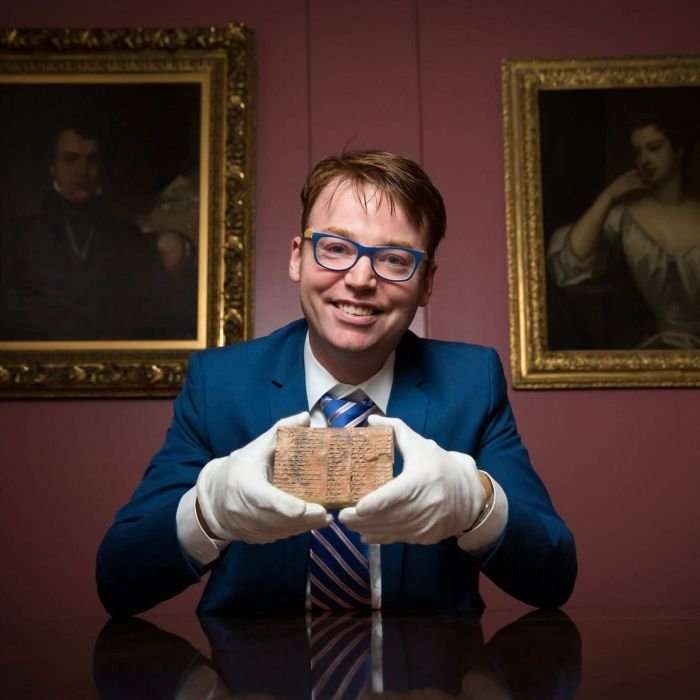Babylonian tablet Plimpton 322 will make studying maths easier, mathematician says
A small clay tablet that is 3,700 years old may be about to make studying trigonometry much easier, thanks to the work of an Australian mathematician.
Key points: Babylonians approach to calculating triangles using simple ratios much more straightforward than our current methods
Discovery has the potential to make maths education easier for teachers and students
"It's rare the ancient world teaches us something new", mathematician says
Daniel Mansfield from University of New South Wales said the palm-sized tablet, covered in rows of tiny numbers in angular cuneiform script, simplifies the study of triangles from using angles and irrational numbers to simple ratios.
"This gives us a different way of looking at trigonometry. One that's really just passed on ratios. And the beautiful thing about it is that it's much simpler," Dr Mansfield told AM.
"It only involves ratios, you don't need to study trigonometry through angles: sin, cosx, tan and irrational numbers. You can do it with just ratios."
The tablet, known as Plimpton 322, was discovered early last century.
In 1945, mathematicians noticed it contained Pythagoras' theorem — named after the ancient Greek mathematician who actually lived more than 1,000 years after the tablet was made — which shows the square of the side opposite the right angle of a triangle is equal to the sum of the squares of the other two sides.
Mathematician Patrick Owen, who has spent decades teaching trigonometry to often reluctant kids, said the discovery had the potential to open children's eyes to mathematics in a more engaging way.
"If that could actually be someone else's perspective, a different perspective on the same knowledge base… so thinking about right-angle triangles, non-right-angle triangles, angles and sides and things like that," Mr Owen says.
"And someone else sees it differently, that could be that they have this different insight that then others can look at and say, 'oh, that's so much clearer'."
This may all sound esoteric, but trigonometry is fundamental to engineering, architecture, oceanography, astronomy and surveying.
In fact, our current understanding of trigonometry comes from the ancient Greek astronomers.
Dr Mansfield said this approach overcomplicated calculations relating to Earth-bound things.
"We're looking at them just as triangles, we're not importing any of these ideas from astronomy," he said.
"The angle is perfect for astronomy, it's great, and it's really helped us out with understanding our triangles.
"But it's not the only way to understand triangles. And yet in our culture we treat it as the only way."
Today, high school students work out the angles of triangles and lengths of sides using trigonometric functions such as sine, cosine and tangent, which are ratios of sides.
Modern trigonometry relies only on approximation.
The Babylonians counted in the same way we count time
We count in base 10, but the Babylonians counted in base 60. We use base 60 too, when we're talking about time.
"Ten … only has two exact fractions: half, which is 0.5, and one fifth, which is 0.2. That's problematic if you want to divide," Dr Mansfield explained.
"For example, one dollar divided by three is 33 cents, with one cent left over."
The Babylonian system has many more exact fractions, meaning they could calculate for engineering projects, like their famed hanging gardens and stepped pyramids, with much greater accuracy.
Dr Mansfield said he was not expecting to see school curriculums changing anytime soon, but maybe his discovery would improve the dim view many students have of maths.
"I hope that teachers might take an interest in it and then pass that interest onto their students, and therefore help everyone like mathematics just that little bit more," he said.
Based on a comparison of writing styles with other Babylonian tablets, Plimpton 322 has been dated to between 1822 to 1762 BC, which is around the time of the Babylonian King Hammurabi.
According to UNSW, Plimpton 322 is a trigonometric table that is the world's only completely accurate one, because it only includes Pythagorean triangles with side lengths that are whole numbers.
"This ensures that the ratios of sides and squared ratios can be represented in the table without approximation," Dr Mansfield said.
"It's rare that the ancient world teaches us something new.
"After 3,000 years, Babylonian mathematics might just be coming back into fashion."
The new study has been published in Historia Mathematica, the official journal of the International Commission on the History of Mathematics.
Topics: mathematics, science-and-technology, engineering, human-interest, university-of-new-south-wales-2052

HAN1776 on August 26th, 2017 at 16:27 UTC »
It's not even more advanced than the Greeks - they didn't have a relationship between angles and lengths and that's pretty fundemental to trigonometry. Still way cool that the Pythogorean Theorem was discovered 1000 years earlier than we thought, but the 'more advanced than our own' angle is 100% bullshit.
GnomeChompksi on August 26th, 2017 at 16:24 UTC »
If it's more advanced than current trig, why don't we just use that instead?
Elmidra on August 26th, 2017 at 15:03 UTC »
A similar post made it to TIL a few days back. Someone correctly pointed out that the important part in math is the proof. The Babylonians may have used some forms of trigonometry earlier than the Greeks, but the Greeks were the ones getting serious about establishing standards for proofs and theorems.
Any dullards can look at a bunch of triangles and make the guess that some relation between their sides (like the Pythagorean Theorem) might be true for some of them. It's getting the proof that it is true where the challenge lies.